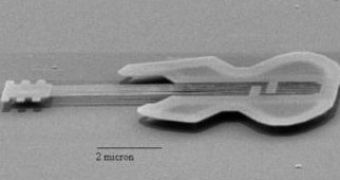Rock carving, created by removing parts of a rock surface, are found worldwide and are often (but not always) associated with prehistoric peoples. They are some of the first forms of art and precursors of technology and writing systems.
Modern day nanoscopic carvings are an expression of the most modern technologies at work, as demonstrated by a team of physicists at the University of Pennsylvania, who used a new technique to craft some of the tiniest metal nanostructures ever created, none larger than 10 nanometers.
The technique is called TEBAL (transmission electron beam ablation lithography) and was used to create carved nanostructures from thin sheets of gold, silver, aluminum and other metals, thus producing new microscopic devices that could find applications in the next generation of sensors and electronics, due to their new mechanical properties.
Tiny structures like nanodisks, nanorings, nanowires, nanoholes and multi-terminal nano-transistors were created by professor Marija Drndic and graduate student Michael Fischbein, from the University of Pennsylvania.
"Many different approaches have been undertaken to fabricate the small structures needed to probe the phenomena that take place at the nanoscale, but the most widely used and versatile techniques are limited to tens of nanometers," said Drndic. "Reliably and consistently fabricating devices at the sub-10-nanometer scale from the top down is generally still challenging, but our technique offers a route to this regime."
This method can spawn a new breed of minuscule superconducting circuits, magnets and molecule-sized transistors, and even a more rapid method of DNA sequencing, using the most important advantage of this technique, the fact that the structures can be imaged with atomic resolution and inspected in real time as they are created.
"It's like using a magnifying glass and sun rays to sculpt an ice cube," says Fischbein. "However, using an electron beam instead of sun rays allows for precision on the atomic scale."

 14 DAY TRIAL //
14 DAY TRIAL //